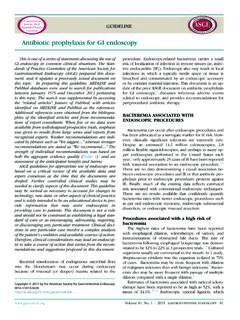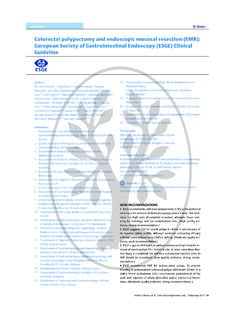Transcription of A Brief History of the Microscope and its ... - SPIE
1 Chapter 1. A Brief History of the Microscope and its Significance in the Advancement of Biology and Medicine This chapter provides a historical foundation of the field of microscopy and out- lines the significant discoveries in the fields of biology and medicine that are linked to the Microscope . Microscopes, which are devices to image those objects that are invisible to the naked eye, were transformed from interesting instruments used by hobbyists to serious scientific instruments used to explore and understand the mi- croscopic world. Because the technique of fluorescence microscopy is a major, if not the most widely used, application of both confocal microscopy and multiphoton ex- citation microscopy, I present a series of key developments of fluorescence micros- copy .
2 Microscopy began with the observation of live specimens and continues its growth with technical developments in the fields of intravital microscopy, endos- copy , and in vivo microscopy. In this chapter, I cite and discuss many of the ad- vances in both biology and medicine that critically depended on the development of the optical Microscope . These sections provide a framework for the book and support the premise that technical advances in microscopy have led to both the gen- eration of new knowledge and understanding as well as advances in diagnostic and clinical medicine, which has ultimately resulted in an improvement of the human condition. Timeline of Optical Microscope Development The invention of the Microscope ( ) and its improvements over a period of 400 years has resulted in great advances in our understanding of the microscopic world as well as extremely important advances in biology and medicine.
3 The opti- cal Microscope , a device that in many cases was used as an interesting toy, became a key instrument in basic science and clinical research: It gives the observer a view of inner space, that is, the world that cannot be observed with the naked eye because of insufficient resolution, such as atoms, molecules, viruses, cells, tissues, and mi- croorganisms. The reader may ask, why were the numerous early advances made in the design and manufacture of telescopes not rapidly transferred to the Microscope ? A partial answer is that telescopes were the domain of physicists and mathematicians, whereas the design, construction, and use of the early optical microscopes were left to laypersons, those whom today we call hobbyists.
4 As we shall see, there were bril- 3. Chapter 2. The Optical Microscope : Its Principles, Components, and Limitations What Is an Optical Microscope ? How does a slide projector differ from a Microscope ? A slide projector magnifies the image on the slide; hence, it projects a small image into a larger image on a screen. A slide projector does not increase the resolution of the object. A Microscope also provides a magnified image for the observer, although its most important function is to increase the resolution! With a Microscope , we can observe microscopic specimens that would not be visible and resolve details that were unresolved to the naked eye. But unless there is sufficient contrast, no details can be observed.
5 So, optical microscopy depends on both sufficient resolution and sufficient contrast. Image Fidelity: Mapping the Object into the Image As in all imaging systems, the optical Microscope maps an object into an image. An ideal system would make this mapping with the highest fidelity between the object and the image. Even so, the finite aperture of the lens as well as many forms of opti- cal aberrations place fundamental limits on the fidelity of this mapping. The aim of Microscope design, manufacture, and practice is to minimize the aberrations, maxi- mize the resolution, and approach the highest fidelity possible. What are the requirements for spatial and temporal resolution in optical mi- croscopy?
6 Spatial resolution denotes the ability of the Microscope to resolve or sep- arate adjacent points on the object. Microscopic observations may only involve the detection or absence of a particle, or may require the full three-dimensional struc- ture of a thick, highly scattering specimen such as the eye or skin. The Microscope should be capable of resolving the highest spatial frequencies that are required to form an image that is appropriate to the questions posed by the observer. In order to map the object into the image with high fidelity, it is necessary to map the intensities and the spatial frequencies of the object. Spatial frequency is the frequency in space for a recurring pattern, given in units of line pairs/mm.
7 The Nyquist theorem, which is valid for both spatial and temporal frequencies, defines how to sample the object. The theorem states that the sampling must be performed at a minimum of two times the highest spatial frequency in the object to accurately reproduce the object in the image. If the imaging system does not meet the Nyquist criterion, then there is aliasing in the image. Aliasing is the phenomenon that occurs when periodic structures in 19. Chapter 6. Early Antecedents of Confocal Microscopy The Problem with Thick Specimens in Light Microscopy It was evident to users of the light Microscope that there were still unsolved prob- lems with thick, highly scattering specimens.
8 The use of the fluorescent light mi- croscope together with fluorescent, thick specimens was difficult; moreover, light from above and below the focal plane contributed to a blurring of the image and a general loss of contrast. These problems were also evident during in vivo micros- copy of embryos, tissues, and organs. On the other hand, these problems did not ex- ist for very thin, fluorescent specimens. Real biological specimens have internal structures that vary with depth and po- sition. Prior to the use of three-dimensional computer reconstructions, in order to obtain a valid understanding of the heterogeneous specimen, it was necessary to use the light Microscope to image many focal planes from the top to the lower sur- face, and then to reconstruct either a mental three-dimensional visualization of the specimen, or use computer techniques to make this visualization.
9 This was the tech- nique used by Ram n y Cajal in his seminal microscopic studies of the vertebrate nervous system. The laser was invented by Theodore Maiman in 1960. Two years earlier, Arthur Schawlow, Charles Townes, and, independently, Alexander Prokhorov showed that it was possible to amplify stimulated emission in the optical and infrared re- gions of the spectrum. The Minsky patent for his confocal Microscope was issued in 1961. Prior to these milestones, there were many technical innovations that aimed to increase the resolution of the light Microscope . The laser is not a requirement for the confocal Microscope , since usable light sources include the sun, white light arc lamps, and a 12V halogen lamp.
10 We now discuss some of these innovations and their role in the development of light microscopy. Some Early Attempts to Solve These Problems A series of creative technical innovations in the field of light microscopy resulted in technical improvements and a deepened theoretical understanding of confocal light microscopy. The basic advances will be briefly discussed and classified into com- mon groupings: advances in fluorescence microscopy and in light sources and point scanning. It is interesting that there were both parallel developments and 69. 70 Chapter 6. reinvention of technical advances in disparate fields, and these processes continued to occur throughout the development of confocal and multiphoton excitation mi- croscopy.




